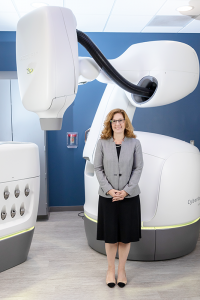Radiation oncologist talks about how the CyberKnife M6 can treat certain cancers more quickly and efficiently
By Chris Motola
 Q: What is the CyberKnife and what’s new with the M6 model Hematology-Oncology Associates is now using?
Q: What is the CyberKnife and what’s new with the M6 model Hematology-Oncology Associates is now using?
A: We started our CyberKnife program in 2007. It was the first robotic radiosurgery program in CNY, and it changed the way we treated a lot of cancerous and even non-cancerous conditions. Patient outcomes have been very successful over the last 10 years, but we wanted to take advantage of the newest system to deliver high precision radiosurgery to the patients that we care for. The M6 is the newest version of the CyberKnife dedicated radiosurgery system. We spent a lot of time researching it and talking to providers who use it in other radiosurgery centers in NYC and other major centers. We started treating with the M6 in April 2018.
Q: What are some of its features?
A: Not only is it faster in treatment delivery, but the algorithms used to calculate radiation plans are improved so the treatment planning process is very efficient. It takes fewer days to derive an excellent plan. The system’s even more accurate, and the real time target tracking has improved. We can lock on to tumors that move with respiration with the automatic motion management system. So patients are more comfortable, they are free-breathing. They don’t have to do abdominal compression or breath holds. We can track tumors that move quite a bit without sacrificing accuracy.
Q: So does the machine visibly move with the patient?
A: Yes, the robotic arm operates about an imaginary sphere around the patient to distribute radiation through hundreds of beam angles. The table that the patient lays on moves not only in the X, Y, and Z axis, but also tilts, so there’s roll, pitch and yaw. Those table movements are determined by the continual feedback from the image guidance system. That’s how we get sub-milimeter accuracy and can spare the adjacent structures and deliver treatment in the most up-to-date manner.
Q: How does it affect outcomes?
A: Outcomes improve when we can safely deliver higher doses of radiation to tumors and this is typically limited by target movement or the risk of radiation to nearby normal organs. When we started in 2007, CyberKnife treatment for early stage lung cancer was considered experimental, but now this is a standard option for patients that are medically comorbid so they’re high risk for surgery or don’t have good pulmonary reserves. We can treat these patients in one week with CyberKnife with excellent local control. There’s rapidly expanding published data that suggests this is an excellent treatment option.
Q: What cancers and tumors respond better to radiation than surgery or chemo?
A: Tumors that are well delineated and localized are more amenable to radiosurgery. Cancers that have lower alpha/beta ratios should respond really well to larger doses of radiation in fewer treatments. That makes localized prostate cancer an ideal target for CyberKnife treatment. We can deliver radiation in five days, which is more convenient for the patient than daily treatment of eight to nine weeks.
Q: How do you like working with it?
A: I’ve been working with CyberKnife for over 10 years, and it’s really changed the way we deliver radiation. The treatments are much more sophisticated. The dose delivered to the nearby structures is much reduced. The M6 system reduces the time it takes to start the treatment, and the treatment itself is about one-third quicker for the patients. It’s delivered over one to five treatments and there is no anesthesia involved. It’s outpatient treatment and treatment typically lasts 30 to 45 minutes. You don’t have to fast or stop blood thinners. The recovery time after the treatment is quite short.
Q: I understand it’s the only one of its kind in CNY at the moment.
A: It’s the only one of its kind in Upstate. There are a few others in New York City, but this is the only one in all of Upstate New York.
Q: What made you guys take that plunge?
A: It was a strategic decision back in 2006 by the CEO Maryann Roefaro and the HOA physician partners. They decided to invest in the technology with the belief that, with all the patients we serve in CNY, this would benefit the greatest number of patients and allow us to treat things we previously weren’t able to treat.
Q: So you must be drawing patients from a huge geographic region.
A: Patients will sometimes come from hours away, and because treatment is completed over the course of a few days, they’ll stay in a local hotel for a few nights.
Q: Do you see this technology remaining really specialized or do you think it’ll be more broadly dispersed in the future?
A: CyberKnife is one example of stereotactic body radiation therapy or SBRT. SBRT systems are becoming more popular and widely used, but the platform and how it’s used differs from center to center. CyberKnife is the only dedicated robotic radiation platform; there’s a linear accelerator mounted on a robotic arm, and the advantage is that it gives us more ways to deposit the dose and more sophisticated ways to deliver the treatment. There are other platforms that do similar things, but they do not have the ability to make automatic corrections for patient and tumor movement. I think overall that radiation oncology is shifting toward more localized treatment. At the same time systemic treatments like chemotherapy and immunotherapy have become more individualized, so that also changes the way we look at things. So we can give higher doses to a more specific area and let the immune system and the newer treatments take care of the rest.
Lifelines
Name: Tracy E. Alpert, M.D.
Position: Medical Director of Radiation oncology at Hematology Oncology Associates of Central New York
Hometown: Staten Island
Education: SUNY Upstate Medical University
Certification: American Board of Radiology, certified in radiation oncology
Affiliations: St. Joseph’s Hospital Health Center; Crouse Hospital
Family: Married (Samuel), two daughters
Hobbies: Piano, teaching daughters music, watching football and golf
In the News
Hematology-Oncology Associates of Central New York (HOA) recently replaced its original CyberKnife with an updated, even more precise, faster and effective version known as the CyberKnife M6 Series. Sub-millimeter accuracy means effective treatment with less harm to healthy tissue and long term negative effects.
Physician Tracy E. Alpert, board certified radiation oncologist, partner and director of the radiation oncology program at Hematology-Oncology Associates, talks about the impact of the new technology.

